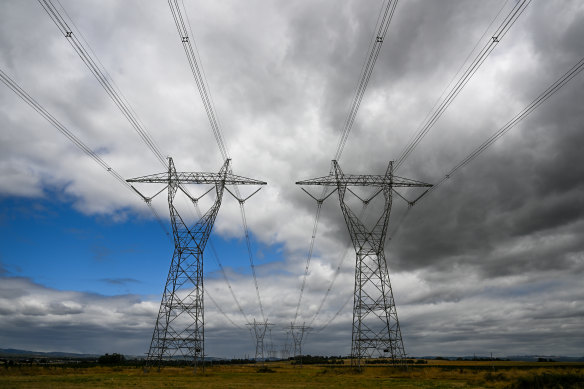By Nick Toscano and Mike Foley
The first fall in power prices in two years has delivered welcome news for the Albanese government as it strives to relieve cost-of-living pressures but Labor is still under pressure to meet the election promise to reduce bills by the end of 2025 by $275.
Households and businesses should get relief from soaring electricity bills within months after authorities on Tuesday released a draft decision to reduce the maximum price retailers can charge most customers on the eastern seaboard.

Two years of sharp increases in power bills across Australia have intensified cost-of-living pressures.Credit: Joe Armao
During the 2022 election campaign, Labor committed to double the share of renewable energy to 82 per cent of the electricity grid by 2030 and cut power bills by $275 by 2025.
For the first time since 2021, the Australian Energy Regulator has opted not to hike the consumer price caps, known as “default market offers”, in most regions. Instead, from July 1, it intends to reduce prices for most customers on standard retail plans by up to 7 per cent for households and up to 10 per cent for small businesses.
For people in Sydney, the Hunter and the NSW Central Coast on the Ausgrid network, prices are proposed to fall by 3 per cent, or $54, compared with last year and by 9.7 per cent, or $487, for small businesses.
In western Sydney, on the Endeavour Energy network, household prices will fall $43 (1.9 per cent).
However, in regional NSW on the Essential Energy network, prices will rise $22 (0.9 per cent) while small business bills will increase $41 (0.7 per cent).
In south-east Queensland, for the Energex network, household prices will rise $53 (2.7 per cent) a year.
Victoria’s Essential Services Commission, which determines its own default offer, has proposed reductions of $112 (6.4 per cent) a year for households and $266 (7 per cent) for small businesses.
Climate Change and Energy Minister Chris Bowen said the draft power bill cuts showed the government’s energy policy to replace coal-fired power with cheaper generation from wind and solar plants was working.
“There’s a long, long way to go, but this is encouraging news,” Bowen said.
“It shows the impact of getting more renewables into the system ... we’ll continue with the task at hand – that is, getting more renewables into the system, which is the cheapest form of energy available.”
The eagerly awaited release of the regulator’s draft price determination follows two straight years of double-digit per cent increases to default offers in 2022 and 2023, blowing out household energy bills by hundreds of dollars.
Bowen said while there was a “huge amount” left to do on energy reform, the government remained committed to its price-cut promise.
The next federal election is due by May next year and the opposition is preparing to attack the government’s energy policies.
Opposition Leader Peter Dutton said the relatively small bill reductions meant Prime Minister Anthony Albanese could now not deliver on his election promise.
“This guy is not believable. His word is worth nothing,” Dutton said, his comments echoed by opposition climate change and energy spokesman Ted O’Brien.
“The game is up on the Albanese government’s promise of a $275 reduction in household power bills,” O’Brien said.
Dutton said the loss of coal-fired power stations was driving instability of electricity supply and raising power prices, while the government’s policies to boost clean energy were adding costs to the energy network.
“Labor has to change its policies, stop killing off gas, fix the mess they created in the renewable rollout … and stop forcing the premature closure of baseload power stations,” he said.
Bowen advised the Australian Energy Regulator to prioritise lowering power bills this year. The agency’s chair, Clare Savage, said the draft determination had placed “increased weight” on protecting consumers amid a challenging economic environment.
Wholesale electricity prices, which typically account for one-third of retail electricity bills, rose sharply in 2022 due to a spate of breakdowns at ageing coal-fired power stations, which forced utilities to buy additional coal and gas to fill shortfalls just as prices were trading at record highs as a result of the war in Ukraine.
Since then, the continuing influx of cheaper renewable energy into the grid has cut the use of more expensive coal-fired power, while milder weather has kept a lid on power demand. In the final three months of 2023, the price of wholesale power fell 24 per cent.
“These latest figures from the energy regulator show that despite fearmongering and misinformation from some quarters, Victoria’s increasingly renewable grid is leading to both lower prices and lower emissions,” Kat Lucas-Healey, senior climate and energy advisor for conservation group Environment Victoria, said.
Australian energy suppliers expressed disappointment that regulators had decided to trim the “headroom” in default market offer calculations that are meant to ensure sufficient competition among retailers.
The Australian Energy Council, which represents major retailers including AGL, Origin and EnergyAustralia, warned that the reduction could force retailers to trim their most competitive offers to make up for costs they cannot recoup from customers.
“Unfortunately, the [regulator’s] decision to reduce the headroom for competition may see some of the cheaper prices disappear, which in the future could negatively affect the more than 90 per cent of customers on market offers,” council chief executive Sarah McNamara said.
The Business Briefing newsletter delivers major stories, exclusive coverage and expert opinion. Sign up to get it every weekday morning.